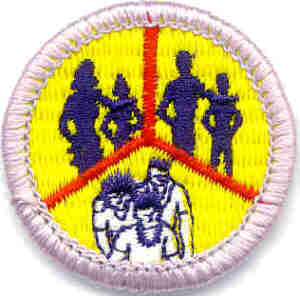
Family Life
- Prepare and outline and discuss with your merit bade counselor what your family is and how the actions of one member can affect the other members.
- List 10 reasons why you are important to your family. Review these points with your parents or guardians and with your merit badge counselor.
- Prepare a list of your regular home duties or chores (at least five) and do them for 90 days. Keep a record of how often you do each of them.
- With the approval of your parent/guardians and your merit badge counselor, decide on and carry out a project that you would do around the house that would benefit the family. Submit a report to your merit badge counselor outlining how the project benefited the family.
- Plan and carry out a project that involves the
participation of your family. After carrying out
the project, discuss the following with your
merit badge counselor:
- The objective or goal of the project.
- How individual members of your family participated
- The results of the project
- Do the following:
- Discuss with your merit badge counselor how to plan and carry out a family discussion.
- After this discussion, plan and carry out
a family discussion to include the
following subjects:
- How to avoid the use of drugs and drug abuse
- Understand the growing-up process, how the body changes and making responsible decisions dealing with sex
- Personal and family finances
![]() Eagle Requirement
Eagle Requirement
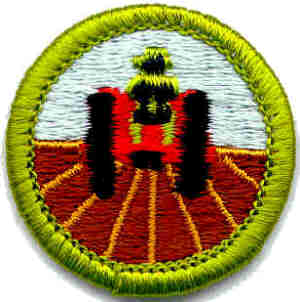
Farm Mechanics
- List 10 common tools found in a well-equipped farm shop and explain how to safely use each one.
- Explain how power is produced or transferred in
a:
- Diesel engine
- Hydraulic system
- Transmission or any other power system.
- Do ONE of the following:
- Put a new handle in any tool found on the farm.
- Build a tool rack with storage for nails, bolts, nuts, and washers.
- List safety features that should be found in a farm shop.
- Do ONE of the following:
- Adjust farm equipment or machinery.
- Pick a piece of farm machinery or equipment. Check all nuts, bolts, and screws. Tighten any that are loose. Replace those that are missing, worn, or damaged. List things you did.
- Repair broken or worn farm machinery or equipment.
- Do ONE of the following:
- Do the following on an engine-powered machine: grease, change oil and oil filter, clean air cleaner, flush cooling system, clean radiator fins, replace diesel fuel filters.
- With any farm machine, do a daily service check for field use. (Do things needed for best field performance.)
- Prepare any farm machine for winter.
- Visit an implement dealer. Interview the dealer technician or service manager for hints on good preventive maintenance. Ask why it is important. What are the costs? What happens that causes wear or damage? Report what you discovered.
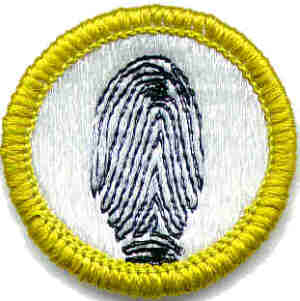
Fingerprinting
- Take a clear set of prints. Use both rolled and plain impressions. Make these on an 8-by-8-inch fingerprint identification card, available from your local police department or counselor.
- Do the following:
- Name the surfaces of the body where friction or papillary ridges are found.
- Explain why plain impressions must be taken on a card.
- Show you can identify the eight types of fingerprint patterns.
- Give a short history of fingerprinting. Tell the difference between civil and criminal identification. Point out the purposes of each.
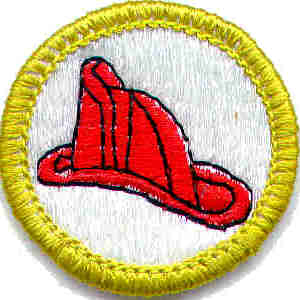
Fire Safety
This Merit Badge was formerly named FIREMANSHIP. No other changes to the requirements were made in 1995.
- Explain the chemistry and physics of fire. Name the parts of the fire tetrahedron. Explain why vapors are important to the burning process. Name the products of combustion. Give an example of how fire grows and what happens.
- Name the most frequent causes of fire in the home and give examples of ways it can be prevented.
- List the actions that cause seasonal fires and explain how these fires can be prevented.
- List common circumstances that cause holiday-related fires and explain how these fires can be prevented.
- List the most frequent causes of burn injuries.
- Conduct a home safety survey with the help of an
adult, then do the following:
- Draw a home fire escape plan, create a home fire drill schedule, and conduct a home fire drill.
- Test a smoke alarm and demonstrate regular maintenance of a smoke alarm.
- Explain what to do when you smell gas and when you smell smoke.
- Explain how you could call in a fire alarm.
- Explain what fire safety equipment may be found in public buildings.
- Explain who should use fire extinguishers and when they can be used.
- Do the following:
- Demonstrate lighting a match safely.
- Demonstrate the safe way to start a charcoal fire.
- Demonstrate how to extinguish a grease pan fire.
- Demonstrate the safe way to melt wax.
- Explain the difference between combustible and noncombustible liquids and between combustible and noncombustible fabrics.
- Do the following:
- Demonstrate the safe way to fuel a lawnmower.
- Demonstrate the safe way to fuel auxiliary heating appliances.
- Demonstrate the technique of stop, drop, roll, and cool. Explain how burn injuries can be prevented.
- Do the following:
- Explain the costs of outdoor and wildland fires and how to prevent them.
- Demonstrate setting up and putting out a cooking fire.
- Demonstrate using a camp-stove and lantern.
- Explain how to set up a campsite safe from a fire.
- Visit a fire station. Identify the types of fire trucks. Find out about the fire prevention activities in your community.
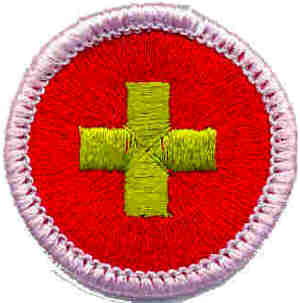
First Aid
- Satisfy your counselor that you have current knowledge of all first aid requirements for Tenderfoot, Second Class, and First Class ranks.
- Do the following:
- Explain how you would obtain emergency medical assistance from your home, on a wilderness camping trip, and during an activity on open water.
- Prepare a first aid kit for your home. Display and discuss its contents with your counselor.
- Do the following:
- Explain what action you should take for someone who shows signs of a heart attack.
- Identify the conditions that must exist before performing CPR on a person.
- Demonstrate proper technique in performing CPR on an adult mannequin for 3 minutes.
- Show the steps that need to be taken for someone suffering from a severe laceration on the leg and on the wrist. Tell the dangers in the use of a tourniquet and the conditions under which its use is justified.
- Explain when a bee sting could be life threatening and what action should be taken for prevention and for first aid.
- Explain the symptoms of heat stroke and what action needs to be taken for first aid and for prevention.
- Do the following:
- Describe the signs of a broken bone. Show first aid procedures for handling fractures, including open (compound) fractures of the forearm, wrist, upper leg, and lower leg using improvised materials.
- Describe the symptoms and possible complications and demonstrate proper procedures for treating suspected injuries to the back, neck, and head. Explain what measures can be taken to reduce the possibility of further complicating these injuries.
- Describe the symptoms, proper first aid
procedures, and possible prevention measures for
the following conditions:
- Hypothermia
- Convulsions
- Frostbite
- Bruises, strains, sprains
- Burns
- Abdominal pain
- Broken, chipped, or loosened tooth
- Knocked out tooth
- Muscle cramps
- Do the following:
- If a sick or injured person must be moved, tell how you would determine the best method.
- With helpers under your supervision, improvise a stretcher and move a presumably unconscious person.
- Teach another Scout a first aid skill selected by your counselor.
![]() Eagle Requirement
Eagle Requirement
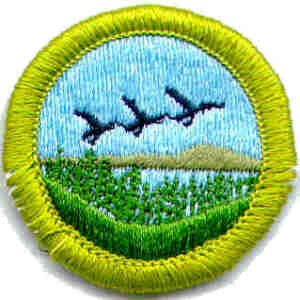
Fish and Wildlife Management
- Describe the meaning and purposes of fish and wildlife conservation and management.
- List and discuss at least three major problems that continue to threaten your state's fish and wildlife resources.
- Describe some practical ways in which everyone can help with the fish and wildlife effort.
- List and describe five major fish and wildlife management practices used by managers in your state.
- Do ONE of the following:
- Construct, erect, and check regularly at least two artificial nest boxes (wood duck, bluebird, squirrel, etc.) and keep written records for one nesting season.
- Construct, erect, and check regularly bird feeders and keep written records of the kinds of birds visiting the feeders in the wintertime.
- Design and implement a back-yard wildlife habitat improvement project and report the results.
- Design and construct a wildlife blind near a game trail, waterhole, salt lick, bird feeder, or birdbath and take good photographs of make sketches from the blind of any combination of 10 wild birds, mammals, reptiles, or amphibians.
- Do ONE of the following:
- Observe and record 25 species of wildlife. Your list may include mammals, birds, reptiles, or fish. Write down when and where each animal was seen.
- List the wildlife species in your state that are classified as endangered, threatened, exotic, game species, furbearers, or migratory game birds.
- Start a scrapbook of North American wildlife. Insert markers to divide the book into separate parts for mammals, birds, reptiles, and fish. Collect articles on such subjects as life histories, habitat, behavior, and feeding habits on all four categories and place them in your notebook accordingly. Articles and pictures may be cut from old discarded newspapers; science, nature and outdoor magazines; or can be photocopied from other sources. Enter at least 10 articles on mammals, 10 on birds, 5 on reptiles, and 5 on fish. Put each animal in alphabetical order. Include pictures whenever possible.
- Do ONE of the following:
- Determine the age of five species of fish from scale samples or identify various age classes of one species in a lake and report the results.
- Conduct a creel census on a small lake to estimate catch per unit effort.
- Examine the stomach contents of three species of fish and record the findings.
- Make a freshwater aquarium. Include at least four species of native plants and four species of animal life, such as whirligig beetles, freshwater shrimp, tadpoles, water snails, and golden shiners. After 60 days or observation, discuss with your counselor the life cycles, food chains, and management needs you have recognized.
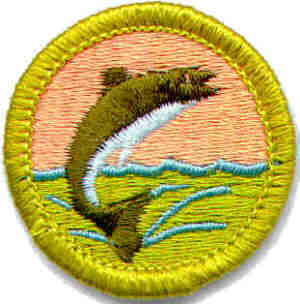
Fishing
- Point out and identify the parts of a saltwater reel, a bait-casting reel, a spinning reel, and a fly reel. Point out and identify the main parts of a fishing rod. Tell how you would care for this equipment.
- Demonstrate the use of two of the three types of fishing equipment (bait-casting, spinning, and fly) and explain how each of the three is used.
- Demonstrate and explain the use of the following knots: clinch, palomar, turle, blood loop (barrel knot), and the surgeon's loop.
- Name and explain five safety practices you should always follow while fishing.
- Name and identify five basic artificial lures and five natural baits and explain how to fish with them. Explain why bait fish are not released alive.
- Give the regulations affecting game fishing where you live. Explain why they were adopted and what you accomplish by following these regulations.
- Catch two different kinds of fish by any legal sportsmanlike method and identify them. Demonstrate how you released at least one of them unharmed. Tell how you cleaned and cooked another fish.
- Explain what good outdoor sportsmanlike behavior is and how it relates to fishermen. Tell how the Outdoor Code of the Boy Scouts of America relates to a fishing sportsman, including the aspects of littering, trespassing, courteous behavior, and obeying fishing regulations.
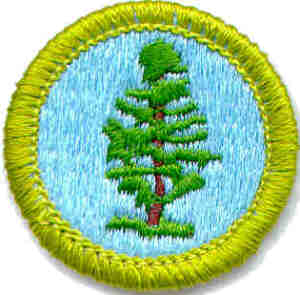
Forestry
- Prepare a field notebook, make a collection, and
identify 15 species of trees and wild shrubs in a
local forested area. Include a written
description of:
- Identifying characteristics of leaf, twig, and fruit samples.
- The habitat in which these trees or shrubs are found.
- Chief ways each tree or shrub is used by human and wildlife.
- The forest's successional stage, what its history has been, and what its future is.
- Do ONE of the following:
- Collect and identify wood samples of 10 species of trees. List several ways each species of wood can be used.
- Find and examine several stumps or logs that show variations in growth rate in their ring patterns. Prepare a field notebook describing their location and discuss possible reasons for the variations.
- Be able to do the following:
- Describe contributions forests make to:
- Our economy in the form of products.
- Soil protection and increased fertility.
- Clean water.
- Clean air.
- Wildlife
- Recreation
- Tell which watershed or other source your community relies on for its water supply.
- Describe contributions forests make to:
- Be able to describe what forest management means,
including:
- Multiple-use management
- Even-aged and uneven-aged management and silvicultural systems associated with each type.
- Intermediate cuttings.
- How prescribed burning and related forest management practices are used.
- Do ONE of the following:
- Visit a managed public or private forest
area with its manager or someone familiar
with it. Write a brief report describing:
- The type of forest.
- The management objectives.
- The forestry techniques used to achieve the objectives.
- Take a trip to a logging operation or
wood-using industrial plant and write a
brief report describing:
- The species and size of trees being harvested or used.
- Where the trees are going to or coming from.
- What products are made from the trees or at the plant.
- How the products are made.
- How the products are used.
- How waste materials from the logging operation or plant are disposed of or utilized.
- Visit a managed public or private forest
area with its manager or someone familiar
with it. Write a brief report describing:
- Be able to do the following:
- Describe the damages to forests that
result from:
- Wildfire
- Insects
- Tree disease
- Overgrazing
- Improper harvest
- Tell what can be done to reduce these damages.
- Tell what you should do if you discover a forest fire and how to control it.
- Describe the damages to forests that
result from:
- Do ONE of the following:
- Assist in carrying out a project that meets one or more of these objectives: timber stand improvement, watershed improvement, wildlife habitat improvement, recreation are improvement or range improvement.
- Take a part in a forest fire prevention campaign in cooperation with your local fire warden, forester, or counselor.
- Visit with one of more local foresters and write a brief report including education, qualifications, career opportunities, and objectives relating to forestry.